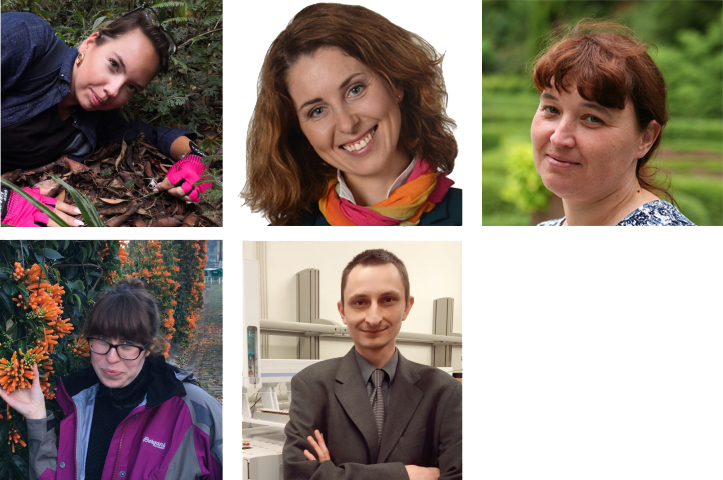
available soon
1. Monika Lipińska - her research interest covers taxonomy, biogeography, and pollination biology of orchids. She has wide expertise in field research, both in tropical (Latin America and Southeast Asia) and temperate regions (Europe). She also has knowledge of orchid cultivation, work with herbarium specimens (dry and preserved in liquids), and material preparation for micromorphological analyses. Her main focus now is an intensification of research on orchid flora in Guatemala, as well as contributing to a better understanding of pollination syndromes in tropical orchids.
https://scholar.google.pl/citations?hl=pl&user=W_VJ22wAAAAJ
2. Aleksandra Naczk - her research interests focus on population genetics, phylogeography, and conservation genetics of endangered species, based on morphological and molecular methods (i.e. nuclear and chloroplast markers). She uses statistical and bioinformatic approaches to process the obtained results. Currently, her main research topic is the understanding Dactylorhiza incarnata/maculata complex at different levels of its organization.
https://scholar.google.pl/citations?hl=pl&user=tAX_UR8AAAAJ
3. Agnieszka Kowalkowska - her interests are concentrated around nectaries and osmophores using light and electron microscopies (SEM, TEM). The majority of publications contains the examination of orchids - from tropical and temperate regions. Plant cell studies give the possibility to localize the secretory tissue, describe cell features and possible route of secretion. Understanding floral biology and pollination mechanisms could greatly influence on conservation strategies to protect biodiversity.
https://scholar.google.pl/citations?user=YbQ-m4IAAAAJ&hl=pl&oi=sra
4. Łukasz Haliński - his scientific profile concerns the chemical aspects of the research and include characterization of plant primary and secondary metabolites (lipids, essential oils, carbohydrates, phenolic compounds) and more complex structures (plant polymers, cuticular waxes) using a number of analytical tools like gas chromatography (GC), high-performance liquid chromatography (HPLC), mass spectrometry (MS), nuclear magnetic resonance spectroscopy (NMR) and others. The main interests cover plant cuticular chemistry, plant-insect interactions, mechanisms of the plant chemical defense, changes occurring during plant domestication and plant chemotaxonomy. The application of multivariate analysis methods for the chemical data processing is also explored as a tool useful in connecting the results of chemical analyses and their biological importance.
https://scholar.google.pl/citations?user=q4ViuXUAAAAJ&hl=pl&oi=ao
5. Julita Minasiewicz - her research interests focus on plant symbiosis with fungi, plant ecophysiology and population genetics using various analytical tools: SSR genotyping, NGS, mass spectrometry (MS) among the others. Currently, she focuses on factors shaping specificity of mycoheterotrophic plants towards fungi.
Kowalkowska AK, Kozieradzka-Kiszkurno M, Turzyński S. (2015) Morphological, histological and ultrastructural features of osmophores and nectary of Bulbophyllum wendlandianum (Kraenzl.) Dammer (B. section Cirrhopetalum Lindl., Bulbophyllinae Schltr., Orchidaceae). Plant Systematics and Evolution 301: 609–622.
https://doi.org/10.1007/s00606-014-1100-2
Lipińska MM, Wiśniewska N, Gołębiowski M, Narajczyk M, Kowalkowska AK. (2021) Floral micromorphology, histochemistry, ultrastructure and chemical composition of floral secretions in three Neotropical Maxillariella species (Orchidaceae). Botanical Journal of the Linnean Society 196(1): 53–80.
Haliński ŁP, Samuels J, Stepnowski P. (2017) Multivariate analysis as a key tool in chemotaxonomy of brinjal eggplant, African eggplants and wild related species. Phytochemistry 144: 87 - 97.
Naczk AM, Kowalkowska AK, Wiśniewska N, Haliński ŁP, Kapusta M, Czerwicka M. (2018) Floral anatomy, ultrastructure and chemical analysis in Dactylorhiza incarnata/maculata complex (Orchidaceae). Botanical Journal of the Linnean Society 187(3): 512–536.
Naczk A, Górniak M, Szlachetko DL, Ziętara M. (2015) Plastid DNA haplotype diversity and morphological variation in the Dactylorhiza incarnata/maculata complex (Orchidaceae) in northern Poland. Botanical Journal of the Linnean Society 178(1): 121–137.
https://academic.oup.com/botlinnean/article/178/1/121/2416402
